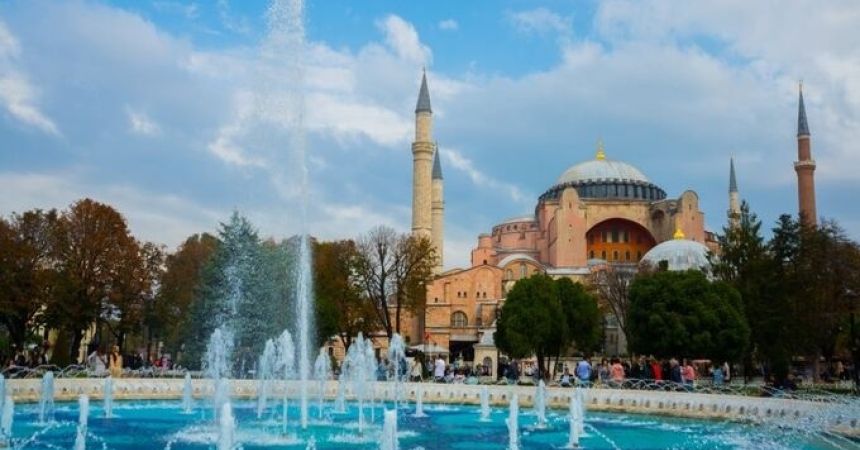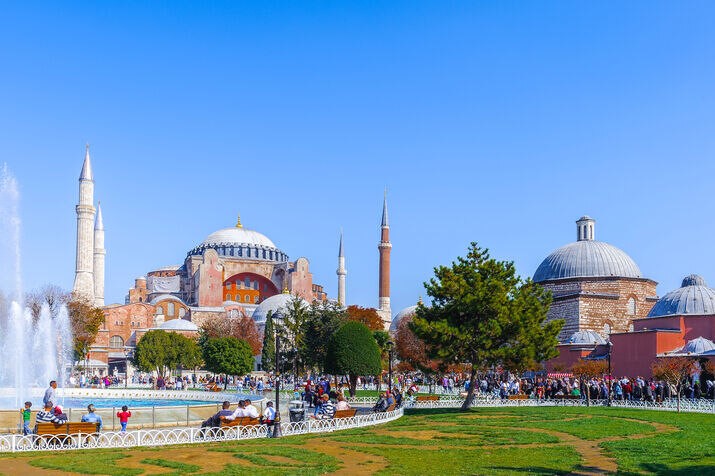
The Hagia Sophia: A Timeless Wonder of History, Faith, and Architecture
The Hagia Sophia stands as one of the most remarkable architectural marvels in the world, bearing witness to centuries of history, religion, and cultural evolution. Located in the heart of Istanbul, Turkey, this awe-inspiring monument has served as a cathedral, a mosque, a museum, and again a mosque, symbolizing the shifting tides of civilizations. Its grandeur, unique design, and historical significance continue to captivate millions of visitors each year. This blog explores the fascinating history, architectural brilliance, and enduring legacy of the Hagia Sophia.
A Glorious Past: The History of the Hagia Sophia
The Byzantine Era: A Christian Masterpiece
The Hagia Sophia’s origins trace back to the Byzantine Empire when Emperor Constantine the Great built the first church on the site in 360 AD. Known as the Megale Ekklesia (Great Church), it was an important religious center in Constantinople, the capital of the empire. However, it was destroyed by fire during riots in 404 AD. A second church, constructed by Emperor Theodosius II in 415 AD, met a similar fate in 532 AD during the Nika Revolt.
Determined to create a structure that would outshine all others, Emperor Justinian I commissioned the present Hagia Sophia. Designed by the renowned architects Anthemius of Tralles and Isidore of Miletus, the church was completed in just under six years, opening its doors on December 27, 537 AD. Its name, Hagia Sophia, means “Holy Wisdom” in Greek, reflecting its role as the spiritual heart of the Byzantine Empire.
For nearly a thousand years, the Hagia Sophia remained the largest church in Christendom. It was the seat of the Orthodox Patriarch of Constantinople and the setting for imperial coronations and major religious ceremonies.
The Ottoman Era: Transformation into a Mosque
The conquest of Constantinople by the Ottoman Empire in 1453 under Sultan Mehmed II marked a turning point for the Hagia Sophia. Rather than destroying it, the Sultan recognized its significance and converted it into a mosque. Islamic elements, such as minarets, a mihrab (prayer niche), and a minbar (pulpit), were added while much of the Christian iconography was covered but not destroyed.
During the Ottoman period, the Hagia Sophia continued to be an architectural inspiration. The famous Blue Mosque, built by Sultan Ahmed I in the 17th century, drew heavily from its design.
The Republic of Turkey: A Museum and a Return to Worship
Following the fall of the Ottoman Empire, Mustafa Kemal Atatürk, the founder of the modern Republic of Turkey, transformed the Hagia Sophia into a museum in 1935. This decision was intended to promote Turkey’s secular identity and preserve the site as a cultural and historical monument.
However, in 2020, the Hagia Sophia was once again designated as a mosque, following a Turkish court ruling. While this decision was met with mixed reactions globally, the Hagia Sophia remains open to visitors of all faiths, continuing to be a cherished symbol of Istanbul’s rich history.
Architectural Marvel: A Fusion of Byzantine and Ottoman Elements
The Hagia Sophia is an architectural masterpiece, blending Byzantine and Ottoman influences seamlessly. Its immense dome, intricate mosaics, and grand interiors make it one of the most visited monuments in the world.
The Iconic Dome: A Feat of Engineering
The most striking feature of the Hagia Sophia is its massive dome, measuring 31.7 meters (104 feet) in diameter and rising 56 meters (184 feet) above the ground. The dome appears to float due to a series of hidden windows at its base, allowing natural light to flood the interior. This innovative design was revolutionary for its time and has influenced countless architectural structures, including St. Peter’s Basilica in Vatican City and the Dome of the Rock in Jerusalem.
The original dome collapsed in 558 AD due to an earthquake but was reconstructed by Isidore the Younger, who reinforced it with a sturdier design.
The Mosaics: A Testament to Byzantine Art
Despite centuries of transformations, many of the original Byzantine mosaics still adorn the Hagia Sophia’s walls and ceilings. These mosaics, made from gold, silver, and colored glass, depict biblical figures, emperors, and religious scenes. Some of the most famous mosaics include:
- The Deesis Mosaic (13th century): A stunning depiction of Christ flanked by the Virgin Mary and John the Baptist.
- The Empress Zoe Mosaic (11th century): Shows Christ enthroned with Emperor Constantine IX and Empress Zoe.
- The Virgin and Child Mosaic (9th century): Located in the apse, this mosaic portrays the Virgin Mary holding the Christ Child.
During the Ottoman period, these mosaics were covered with plaster but were later uncovered during the museum restoration efforts in the 20th century.

The Minarets: Ottoman Influence
The four minarets that frame the Hagia Sophia were added during the Ottoman period. These towering structures were built by different sultans over the years, serving both practical and symbolic purposes. They not only enhanced the mosque’s grandeur but also provided structural support against earthquakes.
Cultural and Religious Significance
The Hagia Sophia’s significance transcends religious boundaries. It has served as a beacon of faith for Christians and Muslims alike, reflecting Istanbul’s unique position as a bridge between the East and West.
For Christianity, it represents the zenith of Byzantine religious art and theology. Many Orthodox Christians regard it as a sacred site, akin to St. Peter’s Basilica for Catholics.
For Islam, it is an important religious site, showcasing Ottoman architectural brilliance. Today, it functions as an active mosque while preserving its rich history for global visitors.
Visiting the Hagia Sophia: A Traveler’s Guide
The Hagia Sophia is one of Istanbul’s must-visit landmarks, attracting millions of visitors annually. Here are some essential tips for exploring this magnificent site:
Opening Hours and Entry
- The Hagia Sophia is open daily, but prayer times may affect visiting hours.
- Since its reconversion into a mosque, entry is free of charge.
Dress Code and Etiquette
- Visitors must dress modestly (shoulders and knees covered).
- Women are required to cover their heads before entering.
- Shoes must be removed before stepping onto the prayer carpets.
Best Time to Visit
- Early mornings or late afternoons are ideal to avoid large crowds.
- Visiting during Ramadan offers a unique experience but can be busier.
Nearby Attractions
- The Blue Mosque – Located just opposite the Hagia Sophia, this stunning mosque is a masterpiece of Ottoman architecture.
- Topkapi Palace – Once the residence of Ottoman sultans, it offers breathtaking views and historical artifacts.
- Basilica Cistern – An underground marvel with ancient columns and an eerie atmosphere.
- Grand Bazaar – A vibrant market with thousands of shops selling textiles, jewelry, and spices.
Hagia Sophia: A Symbol of Timeless Majesty
The Hagia Sophia remains a powerful symbol of history, faith, and architectural brilliance. Its journey from a Byzantine cathedral to an Ottoman mosque, then a museum, and back to a mosque is a testament to Istanbul’s dynamic cultural heritage. Regardless of its function, it continues to inspire awe, reminding the world of the artistic and spiritual achievements of past civilizations.
For those who visit Istanbul, stepping inside the Hagia Sophia is like traveling through time—a journey through the heart of a city that has been a crossroads of empires and a beacon of human ingenuity for over a millennium.



